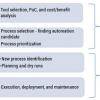Business Transformation Requires Transformational Leaders
Leadership and teaming skills are front and center in times of rapid change. Meet today’s constant disruption head on with expert guidance in leadership, business strategy, transformation, and innovation. Whether the disruption du jour is a digitally-driven upending of traditional business models, the pandemic-driven end to business as usual, or the change-driven challenge of staffing that meets your transformation plans — you’ll be prepared with cutting edge techniques and expert knowledge that enable strategic leadership.
Subscribe to Arthur D. Little's Culture & Leadership Newsletter
Insight
Bob Galen tells of IT leaders who turn to him in frustration as their Agile adoption efforts sputter. Why won’t their teams take the initiative? Why do team members wait to be told what to do? Galen has some uncomfortable news for these clients — it may not be the team but the leader who is at fault.
Jesse Fewell discusses the debate between proponents of a “culture-first” approach to Agile transformation and those who favor a “structure-first” strategy. He describes the pitfalls of each and makes the case that Agile adoption succeeds best when leaders “encourage a conversation that incorporates both perspectives.” He offers three tips for bridging the divide, then introduces the Agile Leadership Canvas.
This article focuses on “Leadership Agility.” The author has done extensive research on leadership and created a leadership development model that works exceptionally well in companies undergoing an Agile transformation.
Based on the demand for Agile skills in the workplace, it is quite clear that leaders across the globe are coming to rely more and more on Agile principles and practices to achieve their goals. What makes some of these leaders successful with their Agile adoptions while other leaders seem to struggle?
Scoping, Implementing, and Scaling Your Digital Backbone
This Executive Update offers some advice on the scoping, implementation, and scaling of the digital backbone, drawing on the lessons the author has learned from his work with transformational change in technology organizations.
Cutter Fellow Professor Rob Austin and Cutter Senior Consultant Sheila Cox have developed two frameworks for leadership training of IT management, which Cutter Consortium has been successfully applying at both large and small organizations worldwide. Taught together, the IT Leadership for Advanced Organizational Capabilities course with Rob Austin and the Personal Competencies: Enhancing Individual Performance with Sheila Cox complement each other perfectly. But they are also powerful when delivered independently. For more information on how you can deliver on the promise of IT through strong leadership, complete our form, call +1 781 648 8700, or send email to sales@cutter.com.
Implementing robotic process automation (RPA) in any organization is itself a process with defined steps. In this Advisor, we discuss the critical junctures required to achieve process automation implementation in any organization.
Creating Great Customer Experiences
In this Executive Update, we look at the most beloved companies and their best practices. We end with a list of questions you can ask about how to improve your customers’ experiences. We also discuss the role that vertical industry location, profit margins by industry, government regulation, and competition play in the customer experience management process to provide context to the explanation and management of customer experiences.
















